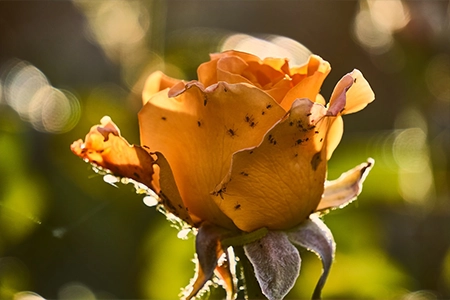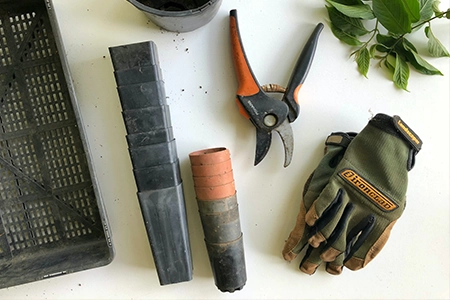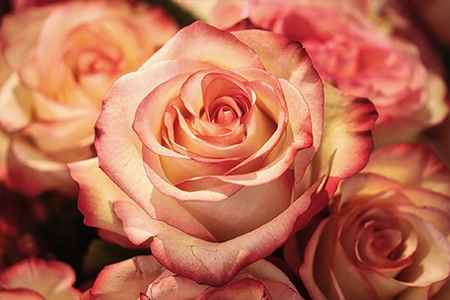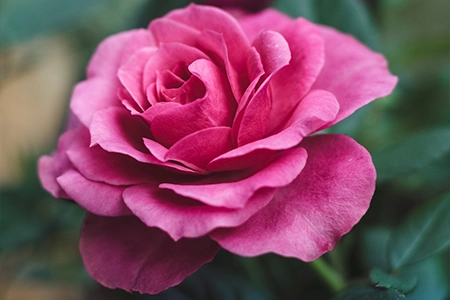Introduction
Roses, often regarded as the queens of the garden, possess an undeniable allure. Their lush petals, exquisite fragrances, and romantic symbolism make them an enchanting addition to any landscape. It’s imperative to understand the when and how of rose pruning. One crucial chapter in the book of rose care is winter pruning, which lays the foundation for a resplendent burst of colour in the forthcoming season.
In this comprehensive pruning roses guide, we embark on a journey through the world of roses, exploring the significance of pruning, the art of winter pruning, specific rose varieties that demand extra attention, and the low-maintenance gems that require minimal trimming. Additionally, we’ll delve into the repercussions of disregarding the timely practice of pruning.
The Importance of Pruning Roses
Pruning roses transcend mere aesthetics; it is a vital component of their overall well-being. The practice of pruning offers several compelling benefits:
Enhanced Bloom
Pruning is akin to a wake-up call for your roses. It prompts new growth, stimulating the production of fresh, exquisite flowers. By removing spent blooms, you redirect the plant’s energy towards the development of vibrant, healthy buds.
Improved Shape
Pruning shapes your rose bushes, maintaining an appealing and balanced form. It prevents overcrowding, ensuring that each part of the rosebush receives adequate sunlight and air, vital for their health.
Disease Control
Pruning roses is an essential aspect of disease management. Trimming away dead or diseased wood eliminates potential breeding grounds for fungal diseases. Moreover, it enhances air circulation and sunlight exposure, which is unfavourable for many fungal pathogens.
How to Prune Roses
Winter pruning is a task best undertaken when your rose bushes are in their dormant phase. The following are the fundamental steps for a successful winter pruning:
Tools
Begin with the right tools—sharp, clean pruning shears. Don’t forget to wear protective gloves to shield your hands from the thorns.
Remove Dead or Diseased Wood: The first step is to excise any dead or diseased branches. This not only enhances the overall health of the plant but also reduces the risk of disease spread.
Cut at an Angle
When making a cut, do so at a 45-degree angle, approximately a quarter-inch above a healthy bud. Make the cut slant away from the bud to prevent water from pooling on the cut, which can attract diseases.
Shape and Thin
Pruning is also an opportunity to shape your rosebush. Remove crossing branches and thin the plant to enhance air circulation, further reducing the risk of diseases.
Specific Roses Requiring Extra Care
Certain rose varieties are known for their demanding nature when it comes to pruning. Their prolific blooming habits necessitate regular deadheading and shaping to maintain a neat and compact appearance, promoting a continuous display of flowers. Below are some examples of those beautiful yet fickle species:
Rosa ‘Mister Lincoln’
Commonly known as the ‘Mister Lincoln Rose’, stands out due to its captivating deep red, velvety blossoms, and is a favourite among rose enthusiasts. However, its allure is accompanied by demanding maintenance requirements. This hybrid tea rose, scientifically known as Rosa ‘Mister Lincoln,’ boasts large, high-centred blooms and a strong, sweet fragrance. To maintain its pristine condition, a comprehensive care routine is essential.
Pruning roses regularly to remove dead or diseased wood and promote new growth is imperative, as neglect can lead to overgrowth and reduced flowering. Due to its dense foliage and susceptibility to fungal diseases, meticulous disease management, including proper air circulation and preventive fungicide treatments, is essential. Fertilization is also crucial for robust growth and abundant flowering, requiring regular feeding with suitable rose fertilizers.
Rosa ‘Double Delight’
The ‘Double Delight Rose’ is a visually captivating hybrid tea rose that demands meticulous care to maintain its unique beauty. This rose variety is distinguished by its striking bicolour blooms, featuring a vibrant blend of creamy white and deep red petals, resulting in an exotic and captivating appearance. However, this striking display comes with specific care requirements.
Pruning roses is essential maintenance and it includes removing spent flowers, maintaining the plant’s shape, and encouraging continuous blooming.
Neglecting this step can lead to a less tidy and less floriferous plant. Additionally, Double Delight, like many hybrid tea roses, is prone to fungal diseases, necessitating adequate air circulation, disease-resistant varieties, and preventive measures to preserve its health. Consistent and appropriate watering practices are crucial for this rose to thrive, with a focus on maintaining soil moisture without overwatering.
Rosa ‘Queen of the Nile’
The Queen of the Nile Rose; lives up to its regal name with its exquisite apricot-hued blooms. These distinctive blossoms not only carry a pleasant fragrance but also exude an air of sophistication in any garden. However, it’s important to note that the Queen of the Nile Rose is considered a high-maintenance choice.
Regular pruning is essential for removing old and dead wood, maintaining a tidy form, and stimulating new growth. Neglecting this aspect can lead to a less appealing plant.
Low-Maintenance Roses
Conversely, some rose types are remarkably low-maintenance, while many rose varieties demand meticulous care and regular pruning, there are those resilient roses that thrive with minimal attention, making them a perfect choice for gardeners who prefer low-maintenance landscapes. Let’s explore three examples of such low-maintenance shrub roses, including their full Latin names:
Rosa ‘Knock Out’
A true champion in the world of low-maintenance roses. This rose variety is celebrated for its remarkable disease resistance and the ability to bloom profusely with minimal care. The Knock Out Rose boasts rich green foliage and a continuous display of single, cherry-red blooms.
It requires only a light annual pruning to maintain its shape, and its naturally bushy form makes it a versatile addition to gardens. Whether planted as a standalone specimen or in mixed borders, it brings a touch of effortless beauty to any landscape.
Rosa ‘The Fairy’
Another outstanding choice for those seeking a low-maintenance rose with enduring charm. This rose variety is beloved for its dainty, fully double, shell-pink blooms that appear in generous clusters. Its natural bushy and compact growth habit makes it a splendid choice for borders, hedges, or as a ground cover.
The Fairy Rose typically requires minimal pruning to maintain its shape and vitality, exemplifying the ease and grace of low-maintenance roses. With its delightful appearance and minimal care needs, this rose variety proves that beauty can indeed be effortless.
Rosa ‘Sally Holmes’
A hybrid musk rose that exemplifies both elegance and simplicity. This low-maintenance rose features large, semi-double to single, creamy white blooms with a hint of pale pink at the centre. Its vigorous growth habit and ability to thrive with minimal pruning make it an excellent choice for gardeners looking for a carefree addition to their landscapes.
The Sally Holmes Rose is also known for its pleasant fragrance and is a favourite among those who appreciate a more relaxed, cottage garden ambience. Whether left to grow as a shrub or trained as a climber, this rose radiates a timeless, natural beauty that requires little intervention.
Consequences of Neglecting Pruning
Neglecting the essential practice of pruning roses at the right time can indeed give rise to a host of issues that can compromise the health and aesthetics of your beloved rose bushes. Here’s a more detailed exploration of the consequences of failing to prune:
Reduced Air Circulation and Sunlight Penetration
When roses are left unpruned, they tend to grow densely, with branches and foliage often intertwining. This dense growth restricts air circulation within the bush, creating a microenvironment that’s conducive to the development of fungal diseases. Without proper air movement, the moist conditions within the foliage can become a breeding ground for pathogens, leading to issues like black spot, powdery mildew, and botrytis.
Less Vigorous Growth
Pruning roses is not just about maintaining an appealing shape; it’s also about stimulating new growth. When roses are not pruned, they tend to focus their energy on maintaining the existing branches and blooms. This results in less vigorous growth and less prolific flowering. With each passing year of neglect, the rosebush may become less robust, with fewer new shoots and less overall vitality.
Fewer Flowers
One of the most noticeable consequences of not pruning is a reduced number of flowers. Roses naturally tend to produce flowers on newer growth, and without pruning, old wood accumulates, which is less likely to yield blooms. Over time, the bush can become top-heavy with excessive, non-productive wood, leading to fewer flowers and an underwhelming display of colour in your garden.
Loss of Graceful Form
Pruning is not just about promoting health and productivity; it’s also about maintaining the aesthetic appeal of your roses. Neglected roses tend to lose their graceful form. As old wood accumulates, the bush may become ungainly, with irregular growth patterns, and eventually, it can present an unkempt and chaotic appearance. The loss of the rose’s natural grace and structure can detract from the overall beauty of your garden.
Conclusion
Pruning roses in winter is a labour of love, an investment that yields dividends in the form of a magnificent floral display in the subsequent seasons. Armed with a deep understanding of the importance of pruning, the right techniques, and insights into specific rose varieties, you can ensure your roses remain robust, exuberant, and a source of pride in your garden. So, as the winter chill settles in, roll up your sleeves, sharpen those shears, and embark on the art of winter pruning. Your roses will repay your efforts with a breathtaking and bountiful bloom that defines the very essence of a beautiful garden. If you would like to read more about how to protect your plants during the winter period then read our blog on protecting perennials. Head to the Contact Us page to find out more.
References













2 Responses
We absolutely love your blog and find nearly all of
your post’s to be what precisely I’m looking for. can you offer guest writers to write content to suit your needs?
I wouldn’t mind composing a post or elaborating on most of
the subjects you write about here. Again, awesome weblog!
Glad to hear you’re enjoying our content! Unfortunately, we are not looking for any guest writers at the moment but thank you for offering your services. Have a great Christmas from us at NGS!